The NVIDIA GeForce RTX 2080 Ti & RTX 2080 Founders Edition Review: Foundations For A Ray Traced Future
by Nate Oh on September 19, 2018 5:15 PM EST- Posted in
- GPUs
- Raytrace
- GeForce
- NVIDIA
- DirectX Raytracing
- Turing
- GeForce RTX
Battlefield 1 (DX11)
Battlefield 1 returns from the 2017 benchmark suite, the 2017 benchmark suite with a bang as DICE brought gamers the long-awaited AAA World War 1 shooter a little over a year ago. With detailed maps, environmental effects, and pacy combat, Battlefield 1 provides a generally well-optimized yet demanding graphics workload. The next Battlefield game from DICE, Battlefield V, completes the nostalgia circuit with a return to World War 2, but more importantly for us, is one of the flagship titles for GeForce RTX real time ray tracing, although at this time it isn't ready.
We use the Ultra preset is used with no alterations. As these benchmarks are from single player mode, our rule of thumb with multiplayer performance still applies: multiplayer framerates generally dip to half our single player framerates. Battlefield 1 also supports HDR (HDR10, Dolby Vision).
| Battlefield 1 | 1920x1080 | 2560x1440 | 3840x2160 |
| Average FPS | 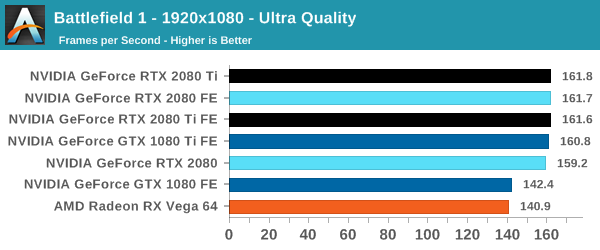 |
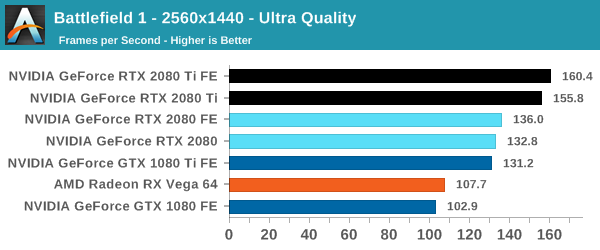 |
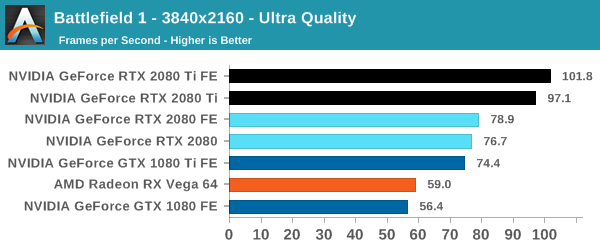 |
| 99th Percentile | 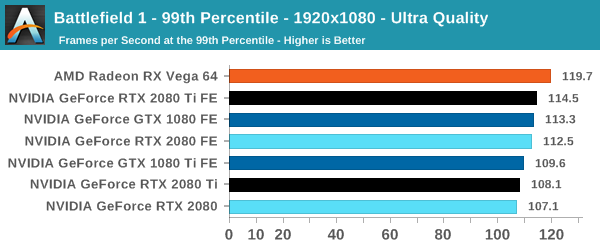 |
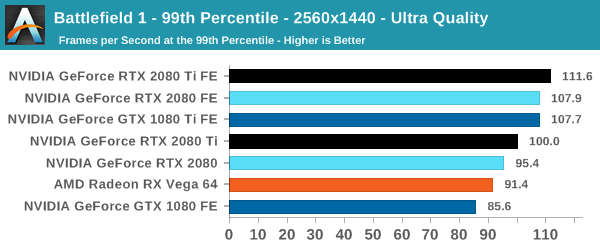 |
 |
At this point, the RTX 2080 Ti is fast enough to touch the CPU bottleneck at 1080p, but it keeps its substantial lead at 4K. Nowadays, Battlefield 1 runs rather well on a gamut of cards and settings, and in optimized high-profile games like these, the 2080 in particular will need to make sure that the veteran 1080 Ti doesn't edge too close. So we see the Founders Edition specs are enough to firmly plant the 2080 Founders Edition faster than the 1080 Ti Founders Edition.
The outlying low 99th percentile reading for the 2080 Ti occurred on repeated testing, and we're looking into it further.


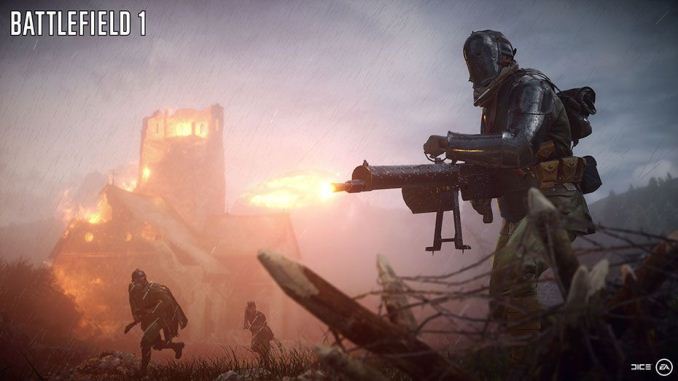









337 Comments
View All Comments
Holliday75 - Friday, September 21, 2018 - link
Good thing there are cops around to keep me honest. If they weren't I'd go on a murder spree and blame them for it.Yojimbo - Wednesday, September 19, 2018 - link
It's NVIDIA making a conscious decision to spend its engineering resources on innovating and implementing new technologies that will shift the future of gaming instead of spending that energy and die space on increasing performance as much as it can in today's titles. If NVIDIA left out the RT cores and other new technologies they could have easily increased performance 50 or 60% in legacy technologies by building chips bigger than Pascal but smaller than Turing, while increasing prices only moderately. Then everyone would be happy getting a card that would be leading them into a gaming torpor. In a few years when everyone is capable of running at 4k and over 60 fps they'd get bored and wonder why the industry were going nowhere.NikosD - Wednesday, September 19, 2018 - link
nVidia has done the same thing in the past, introducing new technologies and platforms like tesselation, PhysX, HairWorks, GameWorks, GPP etc.All of these were proved to be just tricks in order to kill competition, like always, which nowadays means to kill AMD.
Pseudoraytracing is not an innovation or something mandatory for gaming.
It's just another premature technology that the opponent doesn't have in order to be nVidia unique again with huge cost for the consumer and performance regression.
I repeat.
Skip that Turing fraud.
maximumGPU - Thursday, September 20, 2018 - link
i don't think it's fair to compare ray tracing to HairWorks...ray tracing is a superior way to render graphics compared to rasterisation, there's no question about this.
Lolimaster - Saturday, September 22, 2018 - link
But with what, nvidia RTX only do it on a small part of a FRAME, on selected scenes. On tensor core repurposed for that.You will need tensor cores in the 100's to make nvidia implementation more "wowish", 1000's to actually talk about raytracing being a thing.
Consoles dictate gaming progress, AMD holds that.
Lolimaster - Saturday, September 22, 2018 - link
Exactly, to start talking about actual raytracing or at least most of the parts of a scene, we need 10-100x the current gpu performance.Yojimbo - Saturday, September 22, 2018 - link
GPP was a partner promotion program. Hairworks is part of Gameworks. PhysX is part of Gameworks. Gameworks is not a trick, and neither is the PhysX part of it. But neither of them compare to ray tracing. Maybe you should like up what the word "pseudo" means, because you're using it wrong.In 1 year or a year and a half AMD will have their own ray tracing acceleration hardware and then you'll be all in on it.
As for killing AMD, NVIDIA are not interested in it. It wouldn't be good for them, anyway. NVIDIA are, however, interested in building their platform and market dominance.
Yojimbo - Saturday, September 22, 2018 - link
Edit: look up*Eris_Floralia - Thursday, September 20, 2018 - link
I've read all ur comments and still struggle to find any consistent logic.eva02langley - Thursday, September 20, 2018 - link
Nvidia is throwing down the throat of gamers Ray Tracing development. We are paying for something that we didn't even wanted at first.You didn't even know about Ray Tracing and DLSS before it was announced. You are just drinking the coolaid unlike many of us who stand out and raging against these INDECENT prices.